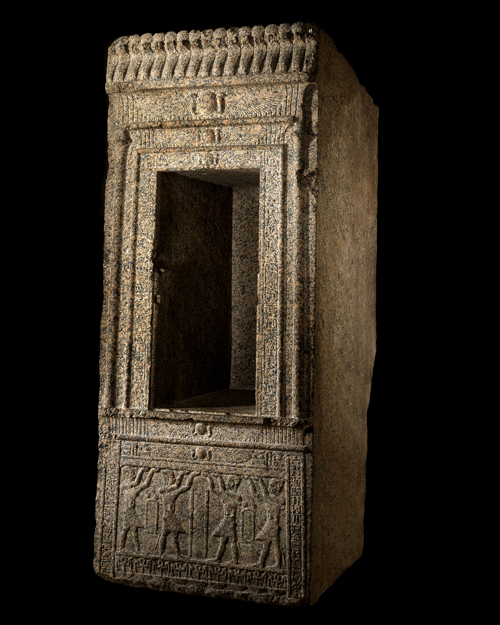
© 2008 Musée du Louvre / Georges Poncet
Aswan, Island of Philae, Temple of Isis
reign of Ptolemy VIII Evergetes
(170-165 and 145-116 BC)
Granite
H.: 2.35 m.; W.: 0.98 m.; D.: 1.20 m; Weight: c. 6 tons.
Department of Egyptian Antiquities, Musée du Louvre
(D 30)
Department of Egyptian Antiquities, Musée du Louvre (D 30)
A statue of a god would be placed in tabernacle called a naos, a Greek term that refers not only to the sanctuary of a temple but also the sacred item of the tabernacle itself, placed within the temple. This tabernacle comes from the temple on Philae, famous for its worship of the goddess Isis. An inscription engraved on the frame of the niche indicates that it was dedicated by Pharaoh Ptolemy VIII Evergetes II and wife to Isis, in order to house one of her statues. On the lower part of the tabernacle, the pharaoh is shown four times; wearing a ceremonial loin cloth, he extends his arms to hold up the sky, here represented by his hieroglyph. The figure 4 corresponds to the four cardinal points of the compass, yet also the four pillars of heaven. Pharaoh here is performing one of his essential duties by maintaining the structure of the universe as it was established at the time of creation. When looking at this monument from the front, we see the structure of the world recorded in stone. The tabernacle rests on the ground, on which stands the king, holding the sky to prevent it from falling. Above the symbol of the sky is the place where the goddess resides, in a sphere distinct from the world over which the pharaoh reigns, and which Isis helps to recreate and sustain thanks to the daily opening of the doors of her tabernacle—those doors being called the “gates of heaven” in Egyptian.